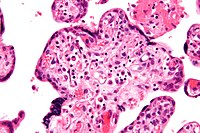
Photo from wikipedia
Background: Placental disorders contribute to pregnancy complications, including preeclampsia and fetal growth restriction (FGR), but debate regarding their specific pathobiology persists. Our objective was to apply transcriptomics with weighted gene… Click to show full abstract
Background: Placental disorders contribute to pregnancy complications, including preeclampsia and fetal growth restriction (FGR), but debate regarding their specific pathobiology persists. Our objective was to apply transcriptomics with weighted gene correlation network analysis to further clarify the placental dysfunction in these conditions. Methods: We performed RNA sequencing with weighted gene correlation network analysis using human placental samples (n=30), separated into villous tissue and decidua basalis, and clinically grouped as follows: (1) early-onset preeclampsia (EOPE)+FGR (n=7); (2) normotensive, nonanomalous preterm FGR (n=5); (2) EOPE without FGR (n=8); (4) spontaneous idiopathic preterm birth (n=5) matched for gestational age; and (5) uncomplicated term births (n=5). Our data was compared with RNA sequencing data sets from public databases (GSE114691, GSE148241, and PRJEB30656; n=130 samples). Results: We identified 14 correlated gene modules in our specimens, of which most were significantly correlated with birthweight and maternal blood pressure. Of the 3 network modules consistently predictive of EOPE±FGR across data sets, we prioritized a coexpression gene group enriched for hypoxia-response and metabolic pathways for further investigation. Cluster analysis based on transcripts from this module and the glycolysis/gluconeogenesis metabolic pathway consistently distinguished a subset of EOPE±FGR samples with an expression signature suggesting modified tissue bioenergetics. We demonstrated that the expression ratios of LDHA/LDHB and PDK1/GOT1 could be used as surrogate indices for the larger panels of genes in identifying this subgroup. Conclusions: We provide novel evidence for a molecular subphenotype consistent with a glycolytic metabolic shift that occurs more frequently but not universally in placental specimens of EOPE±FGR.
Journal Title: Hypertension
Year Published: 2023
Link to full text (if available)
Share on Social Media: Sign Up to like & get
recommendations!